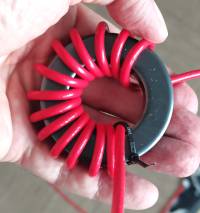K9YC style verticals separate center-fed vertical dipoles from their coax feed lines by means of high impedance RF chokes. First, a short summary of Jim Brown’s original idea[3] and its mention in the ARRL Antenna Book[5]. I then describe my experiments in developing the high impedance broadband RF chokes that make this type of antenna possible.
The K9YC Vertical Dipole
The two halves of K9YC vertical dipoles consist of the shield of a coaxial feed line, and a wire connected to its inner conductor. At first glance they look like ground plane verticals without radials. But that’s because K9YC verticals are dipoles that don’t need radials as counterbalances.
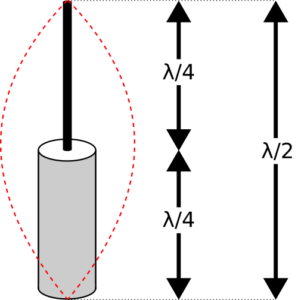
Figure 1 has an idealized K9YC vertical dipole with feeding point in the center, as indicated by the two λ/4 halves and amplitudes of RF currents dashed in red. This configuration is equivalent to a perfect center-fed half-wavelength dipole. But unfortunately, it cannot be connected directly to coaxial feed lines without altering antenna characteristics. Effectively, a coax feed bringing a signal to the lower end of the dipole will turn the configuration into a quarter-wavelength vertical lacking radials.
K9YC’s solution to keeping the structure electrically isolated as well as connected to the transmitter line is to place an RF choke at its lower end. Figure 2 shows a schematic of the choke, which allows signals to pass from the feed line while blocking RF currents from the shield.
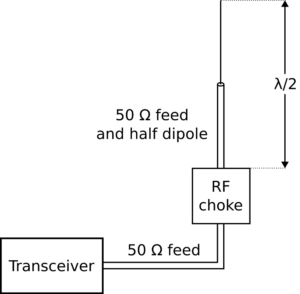
Note that the K9YC design is quite similar to the T2LT. Instead of ferrite chokes the T2LT uses coil of coax feed line as a choke. To me the 8 to 12 cm diameter coils look like their impedance might well be boosted by resonance. If someone tried this, please fill in the gap as a comment.
In my experiments K9YC verticals work well with inductive loading for lower short wave bands.
Advantages of K9YC Vertical Dipoles with RF Choke
Before diving into details of constructing high-impedance RF chokes, some words on why radio hams might find the proposed vertical dipole useful. After all, the construction looks weird and is likely to be met with a good deal of skepticism. Some say it couldn’t possibly work at all due to a lack of radials. Others give it the benefit of doubt, but state that a regular ground-plane would still perform better. I feel such criticism is missing the whole point of using K9YC verticals.
First, vertical dipoles, including many popular CB antennas, are great solution for installations without room for radials. Second, ground-plane antennas only perform well with several radials at right angles. However, most ham ground planes work with only one radial per band. Third, K9YC verticals shift the feeding point half an antenna length up, thus gaining all-important height.
Broadband High Impedance RF Choke Design
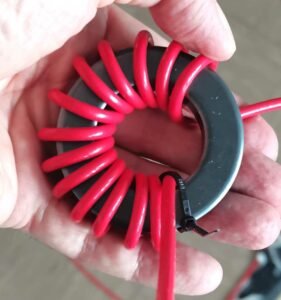
Broadband high impedance RF chokes can be implemented by winding coaxial cable through a ferrite toroid. Such chokes make use of the shielding effect of coaxial cables to separate signals from unwanted shield currents. For signals, the magnetic fields of the shield and the inner conductor cancel each other outwardly. Therefore, the ferrite choke will not attenuate signals between transceiver and antenna. In contrast, shield currents are not canceled out and therefore induce magnetic flux in the ferrite. This fact is well known to the ham community building cable trap baluns.
In summary, RF currents from the lower end of the dipole will “see” the coil as a resistance. However, the signals between transceiver and antenna are only subject to normal cable attenuation along the length of the cable wound through the ferrite.
Appropriate Choice of K9YC Broadband RF Choke Ferrite Material
Creating broadband high impedance RF chokes, I experimented with Amidon FT-240 43[1] and FT-240 77[2] ferrite toroids.
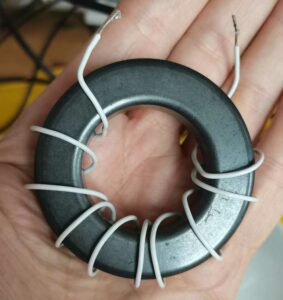
For the FT-240 43 the AL value from datasheet[1] is 1075 nH/turn, note my factor 106 conversion milli to nano. With 10 turns like in Figure 4 the trap coil should have an inductance of 107.5 μH.
L = 10^2 * 1075 * 10^-9 H
L = 1075 * 10^-7 H = 107.5 μHThus, at 7 MHz, the ferrite trap from Figure 4 has a theoretical reactance of XL = 4.7 kΩ. At 28 MHz, the reactance would be as high as 18.9 kΩ. See Appendix 1 giving some theoretical background.
XL = 2 * π * 7 * 10^6 * 107.5 * 10^-6
XL = 4728 ΩIn my installations, I aim for a reactance of at least 10 kΩ over the frequency range of 7 to 28 MHz. Then, theoretically, two FT-240 43 trap coils of ten turns each should suffice for K9YC verticals. Believing the datasheets, traps with FT-240 77 should work even better. Given their AL of 2590 nH/turn, at 7 MHz a 10 turn coil has a reactance of 11.4 kΩ. So one might think that a single coil should safely cover the entire frequency range.
However, measuring the actual resistances of coils, as shown in Figure 4, gives different results. I found that FT-240 77 is good for frequencies below 7 MHz at best. Vertical dipoles with RF chokes using FT-240 43 have much sharper resonances and perform noticeably better.
Practical Choke Implementations for Telescope Towers

Figure 5 shows my approach to mounting the K9YC RF choke on an aluminum telescope mast. The fishing rod serves to pull up the vertical dipole halves. A plastic pipe for electrical installations holds three series-connected inductor coils in a straight row. Installation clamps connect the rod, plastic tube and aluminum pipe.
For the Amidon FT-240 43 material I found no reasonable upper limit of turns using thin Sucoform[4] cable. I could fit 17 turns and estimated no decrease of impedance due to capacities or resonances on 28 MHz. I should mention that I am lacking dedicated equipment for measuring RF impedance. Presently, I am using a dedicated measurement circuit and a digital oscilloscope for this purpose.
Using expensive Sucoform microwave cable is probably overkill. Reduced capacitance and small bending radius aside the stiffness of this cable produces chokes of better mechanical stability.
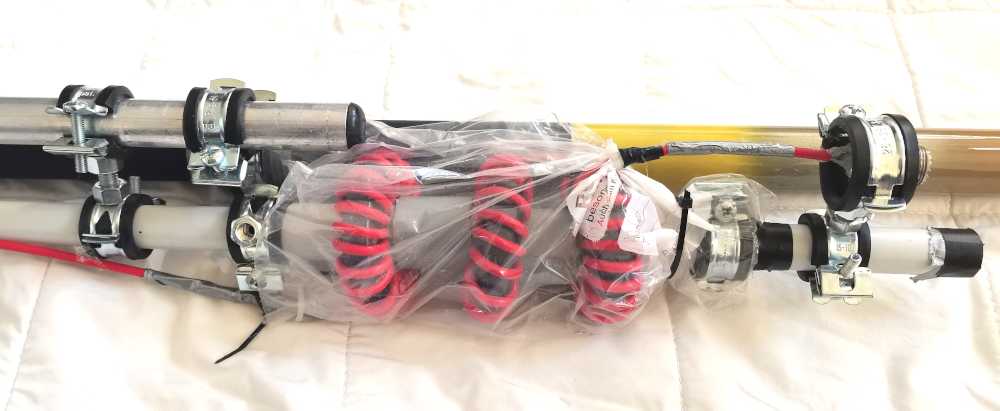
To protect them from the rain, I wrapped the ferrite cores in a freezer bag with the bottom open.
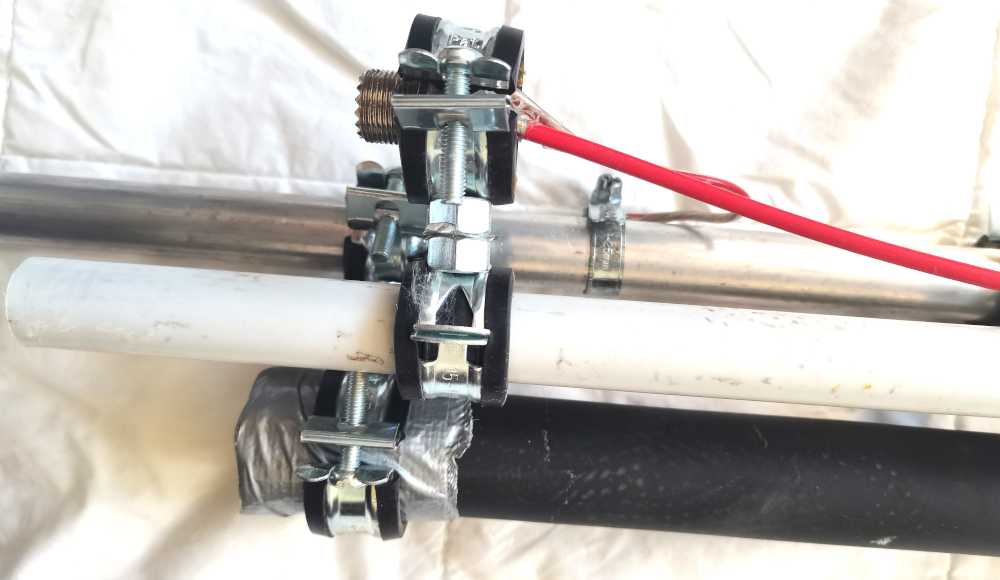
I use installation clamps, available at most hardware stores, to attach the tower to the pole and also to attach the SO 259 sockets.

Figure 8 shows my other experiment building the K9YC from a serial connection of four FT 240-77 coils. This trap will be good for 160 m and medium wave antennas. While the Amidon 77 material is not well suited for frequencies above 3.5 MHz, the RG58 cable seemed to do the trick. I achieved highest impedance fitting 15 turns of RG58.
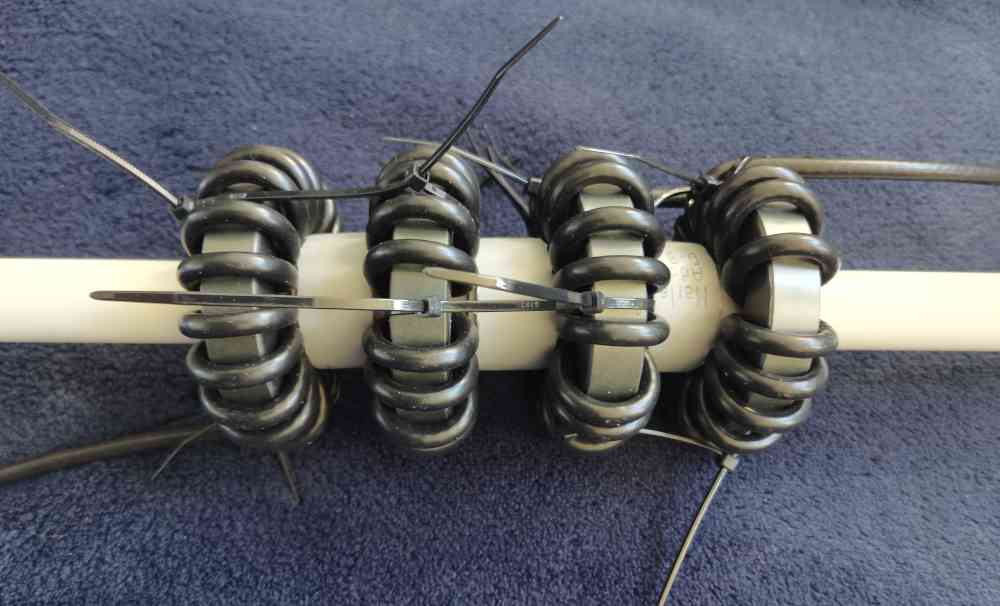
Finally, Figure 9 shows how plastic tubes from hardware stores with slightly larger diameters equally distance the four choke coils. This implementation is a bit over-designed for the kW power range. My other chokes are tested for up to 100 W output power.T
Short Anecdote how I came to use K9YC Verticals
I stumbled upon Jim Brown’s design reading the ARRL book after a stay at my parents’ house, following a sked with an old friend from CB times. As a 12 year old kid, my electronics and radio hobby started with partly home-made CB radios not too compliant with the strict German regulations of the time. Our equipment produced maybe 4 W of RF power, which was well above the 500 mW that Bundespost set as a legal limit for the legendary 12 channels AM. Looking back, it seems surprising such crappy transceivers allowed for stable connections in our small-town. Especially since my friend and I had trouble hearing each other on 21 MHz with modern ham-radio transceivers, ground-plane antennas and 100 W PEP in SSB.
So the much ridiculed CB technology must have done something right! And my only explanation is that our CB vertical antennas must have performed far superior to our amateur radio ground planes. In fact, the reason for the poor ham performance is painfully obvious. Multi-band ham radio verticals typically skimp on a single radial per band, turning the verticals into V-shaped dipoles with irregular radiation patterns.
For CB, we used either end-fed half-wave vertical dipoles, or 5/8 λ verticals. And while my “City Star” half-wave dipole performed slightly worse than 5/8 λ, it had the huge advantage of not requiring space for radials. Exactly the problem I still have as a big city apartment dweller!
Appendix 1: Computing Trap Coil Reactances
Calculating the expected inductance of ferrite toroid trap coils is straightforward. Simply multiply the AL value from datasheets with the square of cable turns!
L = AL * n2
L: coil inductance (in Henry)
AL: ferrite specific inductance per turn
n: number of turnsThe impedance, or roughly resistance to shield currents, is now given by the well known formula for the reactance:
XL = ωL = 2 * π * f * L
XL: reactance (~ resistance)
π: ~ 3.141
f: frequency in Hz
L: inductance in HReferences
[1] Amidon FT-240 43 Ferrite Toroid Data-Sheet
[2] Amidon FT-240 77 Ferrite Toroid Data-Sheet
[3] End Feeding a Center-Fed Vertical Dipole, Jim Brown K9YC
[4] Sucoform 86 FEP Low Loss Coaxial Cable
[5] Vertical Antennas, ARRL Antenna Book, 24th edition, Chapter 9.2
